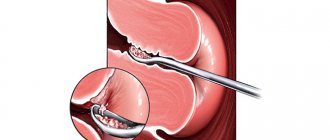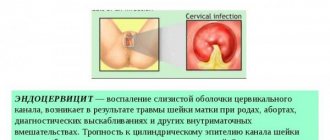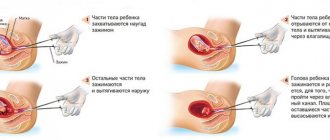Women are sometimes faced with the need to perform a curettage procedure; some tolerate it normally, while others experience complications. But in each case, discharge appears after curettage of the uterine cavity, the nature of which is an important diagnostic sign.
Introduction: What is curettage?
Curettage is a surgical operation. It is performed under general anesthesia, unless there are any contraindications. Such an intervention is carried out to cleanse the uterine cavity of unwanted or, but sometimes doctors prescribe the procedure for diagnostic purposes.
Regardless of the task, the woman has a bleeding wound for several days, because the essence of the operation is the instrumental scraping of living cells. The only difference is the volume of tissue removed.
Therefore, the discharge after curettage of a frozen pregnancy is similar to fluids that naturally drain as a result of intervention for other reasons. However, there are several nuances by which doctors determine the success of the operation and the absence of complications.
In the final phase of the menstrual cycle, the functional layer is rejected, and many women will not notice the difference in menstrual discharge and those after curettage. The uterus will bleed for some time, but many representatives of the fair sex are interested in: how many days will the discharge last after curettage?
In this situation, the complexity of the operation, hormonal levels, blood clotting, and many other factors play a role. However, in clinical practice there are still certain criteria for the normality of such discharge:
- Lasts on average 5-6 days, but no more than 10.
- The intensity of bleeding gradually decreases and the discharge becomes spotting.
- There is pain in the pelvic area.
Each woman has an individual menstrual cycle, depending on the functioning of the ovaries and pituitary gland. If the operation was performed on the eve of menstruation, the bleeding usually stops after 6 days. By the way, this little trick will allow a woman to avoid double torment.
One of the signs of successful healing is after curettage. This color indicates the beginning of blood clotting. However, if they continue after 10 days, then you should consult a gynecologist.
What other symptoms should alert a woman?
Pathological discharge after curettage
It’s good if the operation went smoothly and no difficulties arose. However, in some cases, the discharge becomes pathological:
- They smell bad.
- Too runny and rich.
From such wounds, a liquid exudate is usually released - ichor. If it comes out of the vagina in large quantities, this indicates difficult healing. Particular attention should be paid to the color of the liquid: yellow discharge appears only in case of a bacterial infection. And this is very serious! Doctors typically prescribe a 5-day course of antibiotics after surgery to stop infection.
In addition, pathological discharge often smells bad. The fact is that bacteria, in the process of their life activity, synthesize volatile compounds, which cause an unpleasant and sometimes even pungent odor.
In general, a woman should closely monitor her condition and go to the hospital if she has the following symptoms:
- the temperature rose to 38 °C;
- no discharge;
- severe pain in the abdominal area;
- excessive amount of sputum passing;
- changes in the color, thickness and odor of discharge;
- general deterioration in health (weakness, dizziness, etc.).
Of course, any operation is stressful for the body. Therefore, the temperature will inevitably rise to at least 37 °C, and the patient’s condition will not be the best for a couple of days. In case of severe pain, it is allowed to take an analgesic, for example No-shpu.
However, gradually the body must return to normal on its own. And if this does not happen, the doctor may suspect complications and prescribe additional examination.
Possible complications
The presence of pathological discharge is an indirect sign of complications. They provide grounds for an in-depth examination using ultrasound. In addition, biological material is often taken to be studied for bacterial infection. Such diagnostic measures are necessary to accurately determine the nature of the pathology, because treatment will depend on this.
And the sooner a woman seeks help, the better. What complications can a patient expect after surgery?
- Uterine bleeding.
- Hematometra.
- Endometritis.
Uterine bleeding occurs due to poor blood clotting. At the same time, a woman has to change sanitary pads almost 2 pieces per hour.
The consequence may be anemia, which often provokes insufficient oxygen saturation - hypoxia. And this is already fraught with premature tissue death. In particularly severe conditions, doctors even administer Oxytocin to the patient to stop uterine bleeding.
The main symptom of hematometra is cervical spasm, which prevents the free evacuation of fluid. This usually occurs immediately after surgery.
As a result, the uterine cavity fills with blood, and bacteria begin to develop in it. Hematometra is accompanied by pain in the lower abdomen, and to solve the problem, one thing is required - to clear the path for blood.
This can be done either with medications or surgical instruments. But in any case, there is a risk of relapse of spasm and bacterial infection, so after eliminating the pathology, a course of antibiotics is prescribed in combination with antispasmodics.
Endometritis is a fairly common complication after curettage. It manifests itself in the form of inflammation of the uterine mucosa due to the activity of pathogenic microorganisms. The infection enters the organ in different ways, and often from the vagina. Infection is also possible due to medical negligence (insufficiently processed instruments, dirty gloves, etc.).
Yellow discharge and an unpleasant odor from the vagina are rightfully considered to be striking signs of endometritis. At the same time, the patient’s temperature rises and abdominal pain occurs. The pathology is treated with antibiotics.
Women are usually afraid to have an abortion because there is a risk of losing their ability to conceive. Of course, no one is immune from such an outcome, but in medical practice there are not many facts indicating the development of infertility precisely because of curettage. If the uterus initially functioned normally and the operation was successful, in the vast majority of cases the tissue will be restored and the woman will be able to have children.
Question answer
Before scraping, the fair sex is very worried. The concern is understandable, because surgical intervention sometimes provokes serious complications. This is why women have many questions for their gynecologist. And it’s not for nothing that patients are interested: forewarned means forearmed. Below are the most common questions asked in the doctor's office and brief answers.
What should the discharge be like after curettage?
Bloody discharge, like during menstruation, is considered normal. Gradually their intensity decreases, and the color becomes brownish. If the liquid has acquired a yellow tint, smells bad, or looks like ichor, then this indicates pathology.
How long does the discharge last after curettage?
The average duration of sputum discharge is 5-6 days. If the discharge stops after 1-2 days or does not stop after 10 days, you need to go to the hospital.
Does the temperature increase after curettage?
As a rule, body temperature fluctuates between 37-37.5 °C - this is normal. But an increase above 38 °C indicates infection.
What causes pain after curettage?
Surgery is the removal of living tissue. In this case, the nerve endings are damaged and pain in the lower abdomen inevitably occurs. However, this syndrome can be of varying intensity. Severe pain often indicates uterine bleeding, hematometra or endometritis. And if analgesics do not help, then you need to consult a doctor.
Are the norm. The uterus takes a long time to recover, so after surgery, bleeding may occur for 5 days. After this, light, spotting discharge should appear; it lasts about two weeks. When you observe clots in the discharge with an unpleasant odor or atypical color, you should urgently consult a gynecologist. Such symptoms may indicate that a fertilized egg and its tissues are present in the uterus. It is especially dangerous if an infection occurs during curettage.
Pathological discharge after curettage
When the character and color of the discharge changes, a serious infectious disease can be suspected. If you notice that you have yellow discharge after curettage, most likely a bacterial infection has occurred - streptococcus, staphylococcus.
May be a symptom of trichomoniasis, chlamydia. They smell bad. The norm is brown discharge after curettage. This is the final discharge, which indicates that the blood has begun to clot. In the case when they last more than two weeks, a pathological process can be suspected.
Hysteroscopy
One of the modern methods of curettage is cleaning using a hysteroscope. If in the usual version of endometrial removal the physician works blindly, relying on hearing and existing experience, then during hysteroscopy a special device is inserted into the uterine cavity - a hysteroscope.
Thanks to the device, the doctor is able to fully control the curettage process, minimizing the risk of damage to the uterus. In addition, cleaning is carried out more efficiently.
The recovery period after curettage of the uterine cavity ranges from two weeks to a full calendar month. During the entire period, all recommendations received must be strictly followed.
No discharge after scraping
Sometimes after surgery a woman does not have any discharge. This is very bad. The absence of discharge indicates that the surgical intervention is of poor quality. Blood clots have begun to form in the uterus or a hematoma has arisen, which prevents discharge from coming out. In this situation, an urgent consultation with your doctor is necessary. He prescribes a course of antibiotic therapy, and sometimes it is necessary to repeat curettage.
In addition to the fact that there is no discharge, a woman’s body temperature may rise sharply, causing severe anxiety. This sign is alarming; consult your doctor.
What determines the nature of the discharge after curettage?
How long the discharge will be depends on the type of procedure. After an abortion, women experience heavy bleeding for more than a week, especially if the procedure was performed after 12 weeks. After a mini-abortion, the discharge is not so intense and lasts about 3 days.
Completely different discharge after curettage of a frozen pregnancy. There is no need to immediately set yourself up for a bad result; every woman tolerates the procedure differently. If the uterus does not heal for a long time, inflammation can be suspected.
Features of the scraping procedure
The procedure is most often performed in the following cases:
- At .
- After complications during childbirth.
- For endometriosis.
- For uterine polyps.
There are two types of curettage - separate diagnostic (medical abortion) and therapeutic-diagnostic. During the procedures, the endometrial layer is removed from the uterine walls. The procedures differ in the consequences of curettage - after a medical abortion, the discharge is more intense.
When curettage is performed, the endometrial layer is removed from the uterine cavity. In the first two weeks, the woman is bothered by a nagging pain in the lower abdomen. Curettage is a traumatic procedure, after which bleeding cannot be avoided.
After surgery, a woman should carefully monitor that she does not have excessive discharge during the recovery process. You should be concerned if the pad fills within 30 minutes. It is important to pay attention to the consistency and smell of the discharge in order to avoid infection in time.
Bleeding after surgery can last about one week; if it drags on, this is no longer normal. A month after curettage, the discharge completely stops.
It is important to constantly monitor your well-being and promptly see a gynecologist after curettage. With the help of an examination, you can find out how the uterus contracts. Ultrasound helps to find out whether fetal particles remain inside the uterus or not. Also, sometimes a woman additionally needs to take a course of vitamins, possibly hormones, in order to recover after curettage. Some women need psychological help.
Recommendations
After curettage, the woman experiences bleeding. They remain especially strong during the first few hours or days. Then the bleeding subsides. The total duration of the “daub” is no more than 21 days.
If the bleeding suddenly stops, but pain appears in the lower abdomen, this is a sign of the formation of a hematometra or other dangerous condition. The cause is spasm of the cervical canal, as a result of which blood accumulates inside the uterus. Pathology is diagnosed only with the help of ultrasound examination.
In order to prevent the development of hematomas, a woman is prescribed No-Shpa.
If a woman has a pathology of the blood coagulation system, the doctor takes this into account when managing the postoperative period, monitors the hemostasiogram and prescribes appropriate medications.
In addition, in order to avoid the development of complications, it is recommended to take a course of drugs from the category of antibiotics, which prevents the development of inflammatory processes.
The results of histological studies of tissues are ready 10 days after the curettage procedure. They will allow the gynecologist to identify the true cause of uterine bleeding and prescribe adequate drug therapy.
Complications after curettage
- Bleeding in the uterus
. This rarely happens if a woman has a blood clotting disorder. To prevent this unpleasant symptom, you will need an injection of Oxytocin. - The accumulation of blood clots
occurs due to severe spasm in the cervix. Blood clots are dangerous and an infectious disease can develop. To prevent this pathological process, it is necessary to take antispasmodics - No-shpa. This will allow the cervix to completely relax. It is not difficult to detect the pathology; the woman’s discharge stops and she experiences unbearable pain in the abdominal area. - Development of infection in the uterus
. The disease occurs when a large number of microbes settle in the uterus. For preventive purposes, a course of antibiotics is prescribed. During an infection, a woman experiences severe chills and a rise in temperature. - Infertility
. The complication is rare, but still a woman must understand that when deciding on such a procedure, she is taking a risk; problems may arise in the future with conceiving a child.
Thus, after curettage, a woman should carefully monitor the nature of her discharge. At the slightest deviation from the norm, consultation with the attending doctor and timely treatment is necessary.
Curettage of the uterine cavity is performed in some cases for the diagnosis and treatment of gynecological diseases. This procedure is low-traumatic, but after it is performed the patient requires a recovery period. A woman should be prepared for the fact that after cleaning the uterus there will be bleeding. How long this will last depends on the purpose for which and under what circumstances the procedure was performed.
Preparation
In the case when curettage of the uterine cavity is performed on an emergency basis, i.e. A woman is admitted to the hospital with severe uterine bleeding, which cannot be stopped with medication; preparation includes only a few tests.
Before emergency curettage of the uterine cavity due to uterine bleeding, the patient is prescribed the following tests.
- General blood analysis. The study allows you to determine the levels of indicators characterizing the current general state of health: the presence of anemia, acute inflammatory processes, coagulation state (hemoglobin, leukocytes, platelets).
- General urine analysis. Helps to give a general assessment of the functioning of the urinary system - the presence of infection of the pelvis, urethra, bladder, as well as determine the function of nephrons (red blood cells, protein, relative density, cylinders, sugar). The detection of bacteria in urine and an increased number of leukocytes are signs of an inflammatory process occurring in a latent form.
- Test for blood clotting (extended hemostasiogram). This is one of the mandatory studies to determine the rate of blood clotting. It will be necessary in a situation if the patient begins to experience massive bleeding on the operating table, which will need to be addressed urgently.
- Blood type. It is determined for the case of emergency blood transfusion.
- ECG. Allows doctors to assess the work of the heart, since curettage of the uterine cavity during bleeding is performed under anesthesia. And the choice of drug that will be used during cleansing of the uterine cavity depends on the health of the heart muscle.
Blood sampling for HIV and syphilis is mandatory, but doctors do not wait for test results during emergency cleaning due to massive bleeding.
What is uterine cavity curettage, why and how is it performed?
Curettage (curettage) is a procedure for removing part of the endometrial layer. Curettage is performed for diagnostic and therapeutic purposes. In the first case, endometrial cells are sent to the laboratory to be examined for the presence of atypical elements. Diagnosis of the inner layer of the uterus is necessary in case of severe bleeding for an unknown reason, as well as in the detection of tumors on the endometrium. In this case, the gynecologist uses a hysteroscope to examine the organ and makes scrapings.
As a therapeutic measure, cleaning is carried out in the following situations:
- inflammation of the endometrium;
- polyps;
- bleeding, including during menopause;
- menstrual irregularities;
- pathologies of the cervix;
- miscarriage;
- frozen pregnancy;
- consequences of an unsuccessful abortion;
- the presence of placenta particles in the uterus after childbirth.
Before curettage, it is necessary to perform an OAC, a blood test for coagulation, and a smear examination of the vaginal flora. Three days before the procedure, you should stop using vaginal suppositories, intimate hygiene products, gels, ointments, etc. Two days before the procedure, you should avoid sexual intercourse. If a woman is taking medications, you should tell your doctor about this: their use may need to be reduced or discontinued. On the day of surgery, you should limit the amount of food and liquid you consume.
The procedure consists of several stages:
- The patient lies down in the gynecological chair. The doctor administers a local anesthetic to eliminate pain during the procedure.
- A speculum and a hysteroscope are inserted into the cervix. The gynecologist examines the walls of the uterus, assessing their condition.
- Curettage is carried out using a special medical instrument, similar to a small spoon with a long handle - a curette. This device cuts off excess endometrial tissue or removes the remains of the embryo after an artificial termination or a frozen pregnancy.
Upon completion of the procedure, patients feel pain in the lower abdomen, which can last for several days. This is a normal phenomenon: the uterus contracts, cleaning itself. Analgesics can be used to reduce pain. Also, over the course of several days, clots may be released, which decrease every day and after about 10 days should disappear completely. After the operation is completed, sexual intercourse should be avoided for a month.
Why is there discharge after cleaning?
This article talks about typical ways to solve your issues, but each case is unique! If you want to find out from me how to solve your particular problem, ask your question. It's fast and free
!
Cutting off part of the inner layer of the uterus causes bleeding. The larger the area of the organ that is treated, the more blood flows. This is the norm, because such a procedure makes the uterine layer an open wound that will heal over time.
If hysteroscopy was done for diagnostic purposes, the discharge is usually scanty and lasts up to 4 days after curettage. If there has been therapeutic curettage, especially after a miscarriage or termination of pregnancy, the bleeding is more profuse and prolonged. In this case, it is advisable to take hemostatic medications.
The relationship between discharge and type of cleaning
Quite often, women are interested in whether there is a relationship between how long the discharge lasts and a particular task of curettage. A similar dependence exists.
After the procedure of aborting a dead fetus, a woman experiences quite strong discharge. If we talk about how long they can last, then on average their duration is 1.5-2 weeks - provided that the abortion was carried out in the early gestational stages. If a woman is recommended to have an abortion at a later date, then the bleeding itself after cleaning the uterus will be profuse and prolonged.
What should the discharge be like after curettage and how long does it last normally?
Discharge after cleaning the uterine cavity occurs like normal menstruation. Normally, it lasts about 10 days, at first it bleeds profusely, then more and more sparingly. Finally, there is brown discharge after curettage, which indicates the healing process of the uterus. Then it stops bleeding and begins to “smear” with a light color.
How long does the discharge last? The maximum bleeding period should not exceed 10 days while taking hemostatic drugs. The presence of clots in the first days is allowed, but the discharge after cleaning the uterus should not have an unpleasant odor. Yellow or green color of the discharge indicates pathology, the addition of a bacterial infection. If your body temperature increases, you should consult a doctor.
Normal discharge after vacuum
The presence of discharge after vacuum cleaning is a sign of self-cleaning of the uterus. They are observed for a short time and begin immediately after the procedure. On average, the body recovers in 1–3 days, but much depends on the state of health and individual characteristics.
If the pregnancy was terminated after your period was supposed to start, the discharge lasts no more than 2-4 days. After a week, bleeding may return. This is normal and occurs under the influence of hormones. After a mini-abortion, progesterone production suddenly stops.
Some women may experience scanty discharge after vacuum aspiration for 6–10 days. This duration is due to the fact that the abortion was performed when menstruation was delayed on the eve of the critical days.
Primary
On the 1st day there is heavy discharge. During this period, the damaged endometrium is actively restored in the uterine cavity. After an abortion, primary bleeding is scarlet in color and of medium intensity, lasts no more than 3–4 days and may contain clots. These are the remains of the epithelium and fertilized egg. Over time, the volume and quantity of discharge decreases. They turn pale and become uniform.
Brown
One of the signs of a successful vacuum abortion is brown discharge. If they are odorless and the woman does not feel pain or discomfort, this condition is considered normal for the body. When interacting with oxygen, the blood coagulates and darkens, which is why the brown tint appears.
Complications after cleaning the uterus
If bleeding after curettage does not stop after 10 days and pain remains in the uterus and lower back, this may indicate the presence of complications. In this case, you should not delay your visit to the gynecologist.
Curettage can cause the following complications:
- Heavy scarlet bleeding (in an hour a large pad is completely filled) with a large number of clots, accompanied by severe or moderate pain in the uterine area. In this case, paleness of the skin and loss of consciousness are possible. In such cases, there will be no brown discharge, since the symptoms indicate that the patient has problems with blood clotting. This situation requires emergency medical attention. To prevent such cases, a blood clotting test is done before surgery.
- Hematometra is a situation where blood cannot leave the uterus. This picture is usually observed with cervical spasm. Signs of hematometra are an increase in temperature from 37°C, an unpleasant odor from the vagina, severe pain in the lower abdomen, radiating to the lower back. A mandatory symptom is that in the first days after the procedure, the discharge is scanty or absent at all.
- Inflammation of the endometrium. This complication is accompanied by a temperature much higher than 37°C – values can reach up to 39°C. In this case, the patient experiences chills, pain in the lower abdomen, and general malaise. Endometritis develops as a result of the proliferation of pathogenic microorganisms on the inner layer of the uterus. Yellow discharge is possible. This situation also requires hospitalization and drug therapy.
- Infertility. The most rare complication, almost never encountered in women who have undergone uterine cleansing.
Upon completion of curettage, complications do not arise provided that the patient follows all the doctor’s recommendations. During the recovery period, you cannot perform heavy physical work or play sports. It is important to take medications prescribed by the gynecologist (analgesics, hemostatic agents, antibiotics to avoid fever and the proliferation of pathogenic bacteria after curettage).
Dangerous symptoms of pathology after cleaning
Regardless of how long the bleeding continues, a woman should be alerted to certain symptoms. It will indicate a deterioration in general condition and the need for urgent medical attention.
These signs include:
- the formation of severe pain of a cramping nature, spreading not only to the lower abdomen, but also to the area of the entire abdominal cavity;
- nagging pain localized in the lower abdomen, radiating to the lumbar region, hips and groin;
- sudden cessation of bleeding (of any intensity) - this can be a sign of the development of hematometra and, in the absence of qualified medical care, threatens the development of serious complications;
- a rapid rise in body temperature to high levels indicates the development of an infection;
- the inability to eliminate severe pain even by taking strong antispasmodics;
- severe bleeding that does not decrease even several hours after completion of the procedure - filling one pad per hour;
- the appearance of an unpleasant odor in the genital discharge;
- deterioration in general health.
If such symptoms develop, the woman is recommended to undergo urgent hospitalization.
https://youtu.be/2FgXtXh9bmM
Vacuum aspiration is a procedure used to terminate a pregnancy. Compared to curettage, this is a more gentle procedure. Mini-abortion using vacuum is considered a relatively safe and less traumatic method, but this operation involves surgery and requires postoperative rehabilitation.
Discharge always occurs after a vacuum, but it is different for all women. By color, character and intensity, they judge how well the vacuum abortion was performed and how the body is recovering.
When will the menstrual cycle resume?
How long should it take after curettage for menstruation to come? Usually menstruation comes after 24–35 days. In this case, the discharge after curettage should be the same as before the procedure: without an abundance of clots or unpleasant odor, of moderate duration and intensity, and not spotting. At the end of the recovery period, the discharge turns brown. The menstrual cycle will improve 2-3 months after the procedure. If this does not happen, you should contact a specialist to find out how to treat such a deviation.
If curettage was performed during a frozen pregnancy before the 12th week, then menstruation will begin in 4–8 weeks. If the fetus “frozen” in the 2nd–3rd trimester, your period will come in 6–8 weeks, just like after an abortion. Repeated untimely bleeding does not normally occur after cleaning. If after some time it starts to bleed again, the doctor will recommend hemostatic agents and order an examination.
Indications for repeated cleaning of the uterus
Women undergo the procedure of uterine curettage either at their own request for the purpose of terminating a pregnancy or as prescribed by a doctor for any pathology for diagnostic and therapeutic purposes.
Unfortunately, in some cases, uterine cleaning is prescribed again. The cause may be bleeding from the genital tract as a result of insufficient contraction of the uterus, the accumulation of blood clots or the remains of the fertilized egg in the uterine cavity, or the presence of a placental polyp. All this can happen after:
- miscarriage (spontaneous abortion);
- frozen pregnancy (failed abortion), when the fetus stops developing and dies;
- medical abortion or after vacuum aspiration performed in the early stages up to 6 weeks of pregnancy;
- unsuccessful abortion in the early stages up to 12 weeks or in the late stages from 13 to 27 weeks strictly for medical reasons;
- artificially induced premature birth, when termination of pregnancy is required beyond 28 weeks and urgent birth.
In addition, there are gynecological indications:
- recurrent bleeding in postmenopause;
- rare, but repeated curettage after removal of the tumor still occurs.
If endometrial hyperplasia is detected, separate diagnostic curettage of the uterus and cervical canal is normally performed, then repeated cleaning is prescribed:
- after 3 months when atypia is detected for control;
- if a relapse occurs during hormonal therapy;
When is conception possible?
Gynecologists advise waiting to conceive after an abortion or a frozen pregnancy for at least six months. Why so long? The body needs this period for rehabilitation. It is important to wait until the menstrual cycle is restored and the reproductive system is functioning properly. This time can be used for active preparation for pregnancy, including giving up bad habits, taking folic acid, and leading a healthy lifestyle. In this way, you can increase the chances of conceiving again as quickly as possible and bearing a healthy child.
Many women have to deal with rather unpleasant gynecological procedures. But not everyone is aware of the features of such manipulations and how the body should react to them. Thus, a fairly common type of gynecological intervention is considered to be curettage of the uterus, in which the uppermost layer of the mucous membrane of this organ is removed. Today we are talking about what happens after this: how much blood flows after cleaning, you can’t do anything after this manipulation.
Curettage of the uterus can be diagnostic or therapeutic, and it can also be performed during termination of pregnancy. This type of gynecological intervention is performed exclusively blindly using a number of instruments. Therefore, the likelihood of various complications occurring after it is quite high. Readers of “Popular about Health” need to have information about the characteristics of natural discharge after surgery and about the likely manifestations of pathology.
How long does bleeding occur after curettage of the uterus?
?
The vast majority of patients experience bleeding after curettage. Indeed, when carrying out such a procedure, the superficial layers of the endometrium are eliminated, in other words, the uterine cavity becomes, as it were, a continuous wound... Accordingly, after cleaning, blood is not something surprising, since the wound will bleed for some time.
In fact, this phenomenon is considered not dangerous; it is similar to menstrual bleeding, when the functional layer of mucous membranes is rejected naturally.
The duration of bleeding after curettage may vary from patient to patient. The occurrence of moderate discharge within five to six days (maximum ten), which is not accompanied by a specific unpleasant odor, is considered absolutely normal.
Over time, the severity of the discharge should decrease, it becomes as if spotting, and then completely stops.
In addition to the appearance of discharge, pain in the lower abdomen and lower back may normally occur.
Abnormal discharge of blood from the uterus after curettage
Pathological bleeding can be distinguished from normal bleeding based on several signs.
So, we can talk about complications if the discharge continues for more than ten days. Similar symptoms are possible with hormonal imbalance, curettage that occurred in the middle of the cycle, as well as if there is a remnant of pathological tissue in the uterus.
If after the procedure there is discharge with an unpleasant odor and abnormal color, this indicates the development of a complication. So, with the development of the inflammatory process, the discharge looks like specific meat slop, but the intensity of the discharge can be different (minimal bloody discharge or significant bloody discharge is possible). Inflammation is accompanied by fever and pain in the lower abdomen.
Sometimes bleeding, on the contrary, stops prematurely, which may also indicate a pathology, for example, an accumulation of blood in the uterine cavity. This situation occurs when blood clots cannot leave the uterus due to the closure of the cervical canal. In this case, the spotting suddenly disappears, pain appears in the lower abdomen, which is cramping and quite strong, and the temperature increases.
When to see a doctor
?
You should immediately seek medical help:
If after curettage the discharge continues for more than ten days;
If the bleeding becomes heavy and remains so for several hours (the pad fills in an hour or two);
If the discharge suddenly stops a day or two after the intervention, abdominal pain occurs;
If the temperature rises;
If the discharge smells unpleasant;
If there is severe pain in the lower abdomen that is not relieved by analgesics;
If you feel dizzy and weak.
What not to do after curettage of the uterus
?
For one month after curettage, you must abstain from sexual intercourse. Also, you should not use vaginal tampons to absorb discharge; it is advisable to use pads, or even better, homemade gauze pads. It is also necessary to stop douching for a month after the procedure. Visiting a bathhouse or sauna, as well as taking a bath, are also prohibited.
Also, for four weeks after curettage, you should not lift heavy objects and give up all kinds of serious loads.
During this period, it is better to avoid taking any medications except those prescribed by the doctor. The use of products containing acetylsalicylic acid is especially prohibited, as they can cause bleeding.
For six months after curettage, it is necessary to carefully protect yourself using contraceptives recommended by your doctor.
For successful recovery after curettage of the uterine cavity, you must follow the specialist’s recommendations and take the medications prescribed by him. A sudden deterioration in health is a reason to immediately seek medical help.
Curettage of the uterine cavity is a common medical procedure, which is carried out using special surgical instruments and, in fact, is a surgical intervention that is accompanied by all the relevant features of the postoperative recovery period. Curettage is accompanied by instrumental opening of the cervix, which causes severe pain, therefore, in the absence of categorical contraindications, the procedure is performed under general anesthesia. The success of the operation depends on many factors - both on the quality and professionalism of its execution, and on the characteristics of the female body and the presence of concomitant diseases.
The natural consequences are discharge after curettage. Every woman who has undergone this procedure needs to know about the nature and duration of the discharge, so as not to miss the onset of the development of the inflammatory process and other pathological changes.
There are two types of such operations - therapeutic-diagnostic and separate diagnostic curettage, but in terms of the technique of execution, this procedure is identical to medical abortion. Regardless of the purpose of the manipulation, it consists in removing the functional endometrium from the walls of the uterus, after which the cavity is a continuous bleeding wound. Therefore, discharge after diagnostic curettage and curettage of a frozen pregnancy have the same nature and features, because these two procedures, although they pursue different goals, are identical in execution. The only difference is the amount of content removed.
What discharge after curettage is normal?
The condition of the uterine cavity after the curettage procedure is not much different from its condition during the completion of the cycle, because during menstruation the functional layer is also rejected. The duration of menstruation is individual for each woman and is regulated by the activity of the pituitary gland and hormonal levels. Thus, we can say that the discharge after curettage is similar to menstrual discharge.
How long does the discharge last after curettage?
Normally, spotting after curettage does not have an unpleasant odor and lasts about six days. Then their intensity and volume decreases, they become smearing and soon stop. In general, bloody discharge after curettage should not last more than 10 days. They may be accompanied by mild pain in the lower abdomen and lumbar region, which indicates contraction of the uterus.
After the bleeding stops and there are no complications, normal white and mucous discharge returns after curettage.
Reasons for visiting a doctor
You should seek medical help in the following situations:
- with an increase in temperature and pain in the lower abdomen, the appearance of discharge with an unpleasant odor;
- if the discharge is profuse, bleeding cannot be ruled out;
- if it continues for more than three weeks after curettage.
Expert opinion
Daria Shirochina (obstetrician-gynecologist)
Sometimes women note that after curettage there is no discharge at all. This may indicate that they have accumulated in the uterine cavity and for some reason cannot come out. Most often, after a day or two, nagging pain in the lower abdomen appears, which decreases after taking antispasmodics. And after half an hour or an hour, bloody discharge appears. If nothing appears, it is better to consult a doctor for control.










